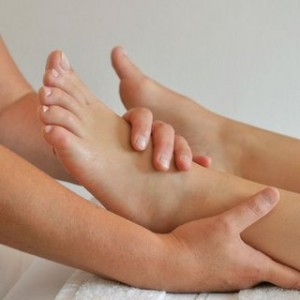As a last resort, insomniac Maria Fitzpatrick tried reflexology – with surprising results.
‘Have you had problems with your spine, madam?” There it is, I think to myself: the question that confirms that I was right to doubt reflexology. I would have been impressed, even hopeful, if the therapist, who knows next to nothing about me (except that I’m seeking a solution for chronic insomnia), had put his finger on my history of kidney problems while kneading my feet, or even found something disrupting the “energy pathway” to my tired brain.
My back – where I’m told there is a “blockage” – is possibly the only part of my body that has never caused me any trouble. It’s easy, at this moment, to see why many traditionalists believe reflexology practitioners to be nothing more than pseudo-science-peddling, fortune-teller masseurs laughing all the way to the bank.
And yet, the art of reflexology, which holds that every part of the body is “mapped” to a corresponding region of the feet, is positively booming in Britain. There are currently an estimated 35,000 reflexologists at work here, pummelling and prodding the nation’s soles – and, less commonly, hands – to provide relief for ailments such as sinusitis, asthma, allergies, migraine, angina and digestive complaints.
In the second in the series Alternative Therapies, tonight on BBC2, Kathy Sykes, the University of Bristol’s Professor of Sciences and Society, investigates the claims of the practice, which has risen from obscurity to the mainstream.
“Conventional medicine has its place, but exploring the alternatives can be very revealing,” says Doreen Baker, chief executive of the Association of Reflexologists. “I personally have benefited from reflexology: it has helped my asthma, and when I was recuperating from breaking my leg in three places, I found that, while a medical doctor’s exercises didn’t help strengthen it, there was a real difference after reflexology.”
The practice has its roots in ancient Egyptian, Chinese and Indian cultures, but was introduced in its modern form in 1915 by William Fitzgerald, an American ear, nose and throat specialist. He noted that pressure on one part of the body seemed to produce a numbing effect elsewhere, and introduced the idea of energy zones, running, not unlike Chinese Meridians, from head to toe.
Then, in the 1930s, Eunice Ingham, an American physiotherapist, wrote a book, Stories the Feet Can Tell, developing the idea that tension in the body can be treated by massaging certain points on the feet. She coined the term reflexology, and one of her pupils introduced the practice to Britain in the 1960s.
Reflexologists believe that “crystalline deposits” of waste products, such as calcium and uric acid, accumulate around the nerve endings, of which there are seven thousand in each foot. By feeling these, a therapist is said to be able to identify a problem in a corresponding area of the body. Massaging these points is said to crush the deposits and stimulate the body to eliminate them, thus healing itself; revitalising the problem area while restoring balance and harmony to the whole person. Other reflexologists hold that its benefits come from stimulating circulation and “energy” via the nerves.
It is clear that there is no single thesis, even among therapists, as to why reflexology “works”. Nor is there a body of convincing scientific evidence showing that it does. Indeed, experts dispute any anatomical link, via nerves or otherwise, between the soles of the feet and the organs of the body.
 And yet GPs, depending on their Primary Care Trust, can now prescribe reflexology on the NHS, along with other unproved complementary therapies. They do so because, for many people, reflexology provides relief for stress or pain. As Doreen Baker says: “We have more than 8,000 registered members. I don’t believe they would all still be in business if people weren’t getting anything out of it.”
And yet GPs, depending on their Primary Care Trust, can now prescribe reflexology on the NHS, along with other unproved complementary therapies. They do so because, for many people, reflexology provides relief for stress or pain. As Doreen Baker says: “We have more than 8,000 registered members. I don’t believe they would all still be in business if people weren’t getting anything out of it.”
Reflexology is essentially a form of massage. Studies have shown that massage can result in many physiological changes in the body, among them lowering blood pressure and levels of the stress hormone cortisol, improving mood and immune function, and altering how we experience pain. While it does not claim to cure, diagnose or prescribe, reflexology, through its links to massage, is building up a stellar reputation in many hospitals, including Charing Cross and Hammersmith, and in Macmillan Cancer Relief hospices, where it is used to provide relief for cancer sufferers. A controlled trial at the Institute of Rehabilitation in Hull, yet to be published, has shown that it helps cancer patients to relax and cope psychologically with the after-effects of chemotherapy and radiotherapy.
As for insomnia – there is an end to my story. The therapist asks me if I have problems with my spine. “No, never,” I reply. However, there is a hot, searing pain when he massages my instep, under the ball of my foot. This spot, he tells me, corresponds to the spine. It hurts considerably more on the left foot, and I volunteer this information. Here, the pain lingers even after the massage is over.
He asks if I’d like him to look at my back. In a series of swift movements, he presses firmly on three points to the left of my spine, between my shoulder blades. And I yell. A knot of muscle, lodged next to my spine, has made its presence felt.
When I stand up from the table, light?headed, I nearly fall over. The next day, the area is red and a little bruised. But my whole posture feels different, realigned somehow. Two weeks later, I am sleeping for seven hours a night; my previous average was about three. Placebo effect it may be, but my head feels clear and my mental block about reflexology has disappeared.
Source: Daily Telegraph UK April 22nd, 2012

Unfortunately, Kathy Sykes did not do bonafide reflexologists any favours last time she did a programme on it. She could not have chosen a more bizarre set of examples if she tried, from therapists who were airy fairy to a woman who had the longest nails I’ve ever seen. There are a great many reflexologists who have nothing more than an HNC level Beauty Based qualification and of course, have no idea or knowledge of any scientific data.
Those of us with our BSc Hons know different, as do the research hospitals, YES Hospitals and Clinics in Denmark where there is an abundance of Clinical and Scientific research been done and countless Science based journals have been published by doctors and nurses on the outcomes etc. There are also scientific research papers from Germany and Austria and clinical trials being conducted. Here in the UK, it’s all about funding, the NHS is badly under funded and the multi billion dollar drug companies don’t want any complimentary therapists upsetting their money making set up.
As for the doubts she aired regards meridians, I came from a Pharmacy background and would urge her to consider the connection to those energy patterns found on an MRI Scan, they also show the flow of energy and any “Hot Spots”, esp in cancer patients so thet proof is already there, in physiological terms that energy pathways DO INDEED exist and furthermore, CAN BE and ARE affected by stimuli of different kinds, including Reflexology.
I would hope that Kathy Sykes would make the effort to seek out those who DO know what they are talking about, speak to the doctors in Denmark, visit their Clinics, not waste time with those who are not qualified and who are in the beauty business rather than than the Health business. She did a great disservice to those of us who are serious practitioners last time by not doing so.
Well said!
All of the clients I worked on in the past twelve years can testify that it is amazing.From a 65yrs old man who had a stroke, mouth was twisted, right arm was numb from the shoulder to the elbow,could not open his finger to hold anything,could not move the upper part of his right leg,and went to doctors over a year.After 18 sessions with me with a specific workout ,he now is talking,writing,moving his arm,opening his fingers and walking,this was without medication.
I worked on a woman in her fifties,she had one session with me,and I saw where one of her ovaries was in trouble,I advise her to go to the doctor and have it checked,to her surprise she had to have emergency surgery,it was a cyst that was causing problems to her ovary.
I did a session on a male client ,after told him want I discovered,he then went to his car and brought out a medical report he got the day before,he shook his head in amazement because it was the same report I gave to him.To those who do not believe, you are missing out on an effective and rewarding treatment of your life.I will never stop doing this service as it comes with fantastic results.
Janine,
What great testimonials for the power of Reflexology!! Thank you for sharing. Anyone else have stories to share?
Lauren
Even though reflexology has been around in some form for thousands of years, there is still no definitive answer as to how it works . It does indeed work as I can personally testify following a spinal injury that doctors said couldn’t be treated. I was so impressed with the outcome that I had a career change & became a reflexologist.
Regards Peter Tomlinson